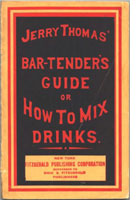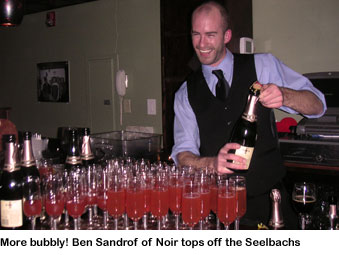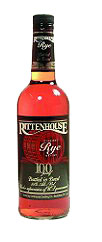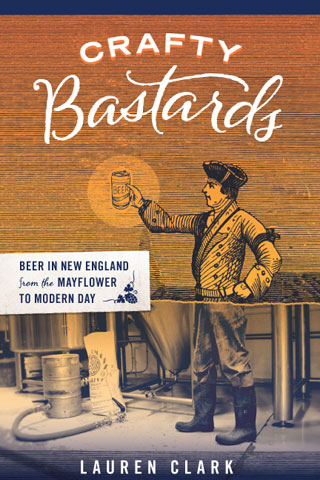Archive for the ‘Bartenders’ Category
March 23rd, 2007
 Todd Maul, who tends bar at the newly re-vamped Rialto in Cambridge’s Charles Hotel, emailed me recently, asking, “Could you do a posting on bartending books?” Specifically, he was curious about which books other ‘tenders around town found most useful. I decided to add to Todd’s idea and ask whether any of Boston’s libation gods and goddesses recommended a particular bartending school.
Todd Maul, who tends bar at the newly re-vamped Rialto in Cambridge’s Charles Hotel, emailed me recently, asking, “Could you do a posting on bartending books?” Specifically, he was curious about which books other ‘tenders around town found most useful. I decided to add to Todd’s idea and ask whether any of Boston’s libation gods and goddesses recommended a particular bartending school.
An informal, off-the-cuff survey yielded the following: 1) Dale DeGroff, Jerry Thomas (1825-1885), and Charles Baker (1895-19??) were the first-, second- and third-most cited bar-book authors; 2) bartending school is generally not recommended — but it’s not entirely dismissed. Survey respondents were Jackson Cannon of Eastern Standard, Brother Cleve (Boston-based cocktail historian), John Gertsen of No. 9 Park, Sean Holland of The Independent, Todd Maul of Rialto, Ben Sandrof of Noir and Max Toste of Deep Ellum. (Thanks, guys.)
Bartending books/authors
* More than one citation
Stanley Arthur – Famous New Orleans Drinks and How to Mix ‘Em
Charles Baker – Gentlemen’s Companion (aka Jigger, Beaker and Glass: Drinking Around the World) *
Harry Craddock – The Savoy Cocktail Book
Dale DeGroff – The Craft of the Cocktail *
David Embury – The Fine Art of Mixing Drinks *
Ted Haigh – Vintage Spirits and Forgotten Cocktails
Paul Harrington – Cocktail: The Drinks Bible For The 21st Century
Stan Jones – Jones Complete Bar Guide
Playboy Magazine – The Playboy Bartender’s Guide
Gary Regan – Joy of Mixology *
Ted Saucier – Bottoms Up *
Eugene Shewmaker – The International Bartender’s Guide
Jerry Thomas – How to Mix Drinks, A Bartender’s Guide *
Jack Townsend and Tom Moore McBride – The Bartender’s Book
Cannon likes Thomas for “the roots, philosophy of the trade and obscure recipe and ingredient info,” David Embury for “recipes and culture,” Gary Regan for “theory of drink relations, technique (watch his recipes though, not always sound)” and Dale Degroff for “recipe, technique and hospitality.” Holland likes The International Bartender’s Guide because, “For me, it’s organized in a way ‘my’ brain understands. I use it on the job for cocktail recipes I’m unsure of.” Maul notes that Bottoms Up has “some cool illustrations, a bit on the erotic side, but well done.” And Toste says he likes Famous New Orleans Drinks and How to Mix ‘Em for its “historical reference and background on cocktails, Craft of the Cocktail for its modern take on classic cocktails and history of barmanship, and the Playboy Bartender’s Guide for its huge volume of recipes.”
Bartending school
Cleve: “Go work for Misty (Kalkofen), John, Jackson, Ben or John Byrd.”
Cannon: “I don’t think bartending school is the way the go. I always recommend getting any job that is open in a bar/restaurant that you admire. Watch and learn from the bartenders and study [Degroff, Embury, Regan, Thomas].”
Gertsen: “I really don’t have much experience with bartending schools. I met recently with teachers from Johnson and Wales, and it seems like they are launching a great mixology program there. And finally a quote from the late Max Allen Jr. (Bartender Emeritus of the Seelbach Hotel): ‘It takes five years to learn how to bartend; the first two to learn what to do; the second two to learn what not to do, and the last year to learn how to do it nicely.'”
Holland: “Bartending schools?… well, never been. There was once a woman at [the Independent] who insisted that an Alabama Slammer was made with Absolut vodka… and she told me that she should know because she went to bartending school. If anything, I would recommend someone OPEN a bartending school — seems a lot of people go who never end up bartending.”
Maul: “Yes, I did go to bartending school. It was in 1992 in Albany, NY. I don’t remember what the name was or what it cost… I’m not sure I would recommend sending anyone to bartending school. I think picking up Sundays or that one ‘no one wants it shift’ as a bartender is the best way to get your foot in the door.”
Sandrof: “I went to the Professional Bartending School of New England. It was a week-long course consisting of five classes. I would not say that I consider it a complete waste of time, but I could teach someone all the info in a day if they wanted to learn. What it was good for, however, was allowing you to become familiar with bottles, speed pours and tools. We also had to memorize the top 30 drinks, and that came in handy. When someone asked me to make them a martini or a margarita, I did not have to stare back blankly. IT DID NOT, however, help to get me a job. I found that most people in the restaurant industry do not consider a bartending course important at all. It doesn’t hold a candle to actually having experience behind a bar. It just seems to be one more credential on a resume.”
Toste: “I don’t recommend it. I recommend going out and getting a job at a bar, watching and learning, going out to bars as a customer and observing other bartenders, reading books and stocking your bar at home. Good barmanship is as much about good service as good technique.”
Posted in Bartenders, Books & resources | 10 Comments »
February 14th, 2007

What better way to spend a Monday night in February than at a cozy neighborhood restaurant drinking champagne cocktails mixed by some of Boston’s best bartenders? That’s the sound reasoning that brought 60+ people to Green Street last night for drinkboston.com’s sold-out champagne cocktail party. Misty Kalkofen of Green Street and the B-Side Lounge, Ben Sandrof of Noir, Dylan Black of Green Street and John Gertsen of No. 9 Park mixed four distinctive classic cocktails using champagne: the Diamond Fizz, the Black Velvet, the B2C2 and the Seelbach (recipes below). Not only that, they visited each and every table in the room, explaining the drinks’ origins (or alleged origins, given that the history of cocktails is usually as unverifiable as the provenance of traditional folk songs). The evening was festive and informative — well worth the price of a small headache on Tuesday morning.
To get on the email list for future drinkboston.com events, email drinkboston at comcast dot net.
 The cocktails
The cocktails
B2C2
1 oz each of brandy, Benedictine and Cointreau shaken over ice and strained. Top with champagne.
Misty learned of this drink from David Wondrich’s Killer Cocktails: An Intoxicating Guide to Sophisticated Drinking. It was “created by American intelligence officers at the end of WWII. They had all of these wonderful goods that had been looted from the French by the Germans and then left behind during the Germans’ retreat,” she says. Luxurious bubbles.
Diamond Fizz
2 oz gin, 1 oz lemon juice and 1/2 tsp powdered sugar shaken over ice and strained. Top with champagne.
A dressed-up gin fizz (which uses seltzer instead of champagne). Also similar to the French 75, only it contains less sugar and no garnish. The Cocktail Database recipe calls for a highball glass with ice, but we served it straight up in a saucer. Delicious either way.
Black Velvet
1/2 stout and 1/2 champagne in a wine glass or flute.
Said to have been created at London’s Brooks Club in 1861 during mourning over Prince Albert’s death. Also called the Bismarck, as the drink was a favorite of German statesman Otto von Bismarck. Dylan used Mackeson’s Stout for this drink. Dark and rich.
Seelbach
1 oz bourbon, 1/2 oz Cointreau and 7 dashes each Angostura and Peychaud’s bitters poured into a flute and stirred. Top with champagne.
Invented at the Seelbach Hotel in Louisville, Kentucky, circa 1917. The recipe was lost, probably during Prohibition, until being rediscovered by the hotel in 1995 and later printed in Gary and Mardee Regan’s New Classic Cocktails. This is one of the great whiskey drinks.
Posted in Bartenders, Beer, Brandy, Champagne, Cocktails, Events, Gin, Liqueur | No Comments »
January 30th, 2007
In a nice alignment of the stars, both drinkboston.com and one of Boston’s best bartenders, John Gertsen, are currently featured on Playboy.com. John, principal bartender at No. 9 Park, makes Playboy.com’s list of America’s Top 10 Bartenders. Congrats, John! Well deserved. You can see this guy in action at drinkboston.com’s upcoming champagne cocktail party at Green Street.
Another article, Brew Romance, describes 10 top American microbrews selected from votes by a panel of beer experts. That panel included drinkboston.com’s publisher, me. Yep, that’s right — it’s not all about cocktails for this imbiber. You can find a few of the Ms. Mug columns I write for the beer newspaper Ale Street News here.
Posted in Bartenders, Beer, Booze in the news, drinkboston in the news | No Comments »
January 12th, 2007
 Radius, which has been on the short list of Boston’s best restaurants since chef Michael Schlow opened it in 1999, specializes in the kind of contemporary cocktails found in most chic dining spots. That is, cocktails with up-to-the-minute ingredients that change with the seasons, much like the dishes on the menu. Example: the late-summer Family Heirloom, a chilled, straight-up mixture of heirloom tomato water (the colorless, pulpless, pure liquid from an heirloom tomato), Absolut Citron, Absolut Peppar, lemon and lime juice, a splash of simple syrup and a few drops of parsley oil, which form gem-green circles on the surface of the drink. I know: half of you are saying, “Mmmm, delicious,” and half of you are saying, “That’s preposterous.” You’re both right.
Radius, which has been on the short list of Boston’s best restaurants since chef Michael Schlow opened it in 1999, specializes in the kind of contemporary cocktails found in most chic dining spots. That is, cocktails with up-to-the-minute ingredients that change with the seasons, much like the dishes on the menu. Example: the late-summer Family Heirloom, a chilled, straight-up mixture of heirloom tomato water (the colorless, pulpless, pure liquid from an heirloom tomato), Absolut Citron, Absolut Peppar, lemon and lime juice, a splash of simple syrup and a few drops of parsley oil, which form gem-green circles on the surface of the drink. I know: half of you are saying, “Mmmm, delicious,” and half of you are saying, “That’s preposterous.” You’re both right.
Walking into a swanky place like this, you are right to assume that there are professionals working behind the bar. But you also wonder, ‘Will they give me the time of day if I’m not carrying a Prada bag?’ Karen Olson puts those fears to rest. This barwoman has an easy, genuine laugh and readily admits to being a geek; she’s addicted to playing Who Wants to Be a Millionaire on her cell phone. And it doesn’t hurt that she looks like an Ivory girl. Karen moved to Boston from the Midwest several years back and developed her chops where all out-of-towners congregate when they first arrive in Boston — Legal Sea Foods. She eventually made her way to Radius as a bartender and server.
When I ordered a Pink Cashmere (Plymouth gin, Campari, Cointreau, lime, grapefruit soda and muddled black peppercorns over ice), Karen told me that she and her co-bartenders decreed that every Radius cocktail menu include a drink named after a Prince song (the Raspberry Beret preceded the Pink Cashmere, which I’m going to admit I didn’t know was a Prince song). Some of the most frou-frou-sounding drinks here have surprising backbone, like the Floating Cloud: Bacardi light and Myers dark rum, apple cider and Frangelico topped with almond-flavored whipped cream. Lurking underneath the frothy topping is a belt of rum worthy of a sailor.
The Rosemary Gimlet (pictured), an Olson creation, is my favorite drink at Radius: Hendrick’s gin, lime juice, simple syrup and muddled fresh rosemary topped with ginger beer. It’s the perfect balance of “classic” and “creative” mixology. Have one of these with the duck quesadilla, the frites with three dipping sauces … or anything on the menu, really. Radius gets its bar food right with comforting, familiar-sounding dishes that are kicked up to the level of great cuisine.
Posted in Bartenders, Boston bars, Cocktails | 1 Comment »
December 13th, 2006
 Oh no. Smell that? It’s the latest liquor trend: top-shelf rye whiskey. We’re talking $50, $100 bottles of the stuff that, if you ordered it in a bar a few years ago, you were probably an 80-year-old man drinking Canadian Club. In the average American bar, Canadian whiskey is what you get when you order rye, because U.S. rye distilleries dwindled and nearly died out in the decades following Prohibition.
Oh no. Smell that? It’s the latest liquor trend: top-shelf rye whiskey. We’re talking $50, $100 bottles of the stuff that, if you ordered it in a bar a few years ago, you were probably an 80-year-old man drinking Canadian Club. In the average American bar, Canadian whiskey is what you get when you order rye, because U.S. rye distilleries dwindled and nearly died out in the decades following Prohibition.
“Now, though, in a turnabout, the prospects for rye have brightened considerably,” wrote the New York Times’ Eric Asimov late last month (All but Lost, Rye Is Revived As the Next Boutique Find). The article reviewed several ryes, at least half of which were between $65 and $140. “Fueled by the same sense of curiosity and geeky connoisseurship that gave birth to the microbrew industry, the single-malt avalanche and myriad small-batch bourbons, rye has been resurrected by whiskey lovers who want to preserve its singular, almost exotic essence.”
Oh crap.
Look, I’m one of those geeky connoisseurs. I used to be in the microbrew industry. I have six different kinds of bourbon in my house right now. And I admit my life changed a little the first time I tasted Van Winkle Family Reserve 13-year rye. That’s why I now have four different kinds of rye in my house, mingling with the bourbon bottles. But articles like this give me a sinking feeling. I mean, $140 rye? Who’s drinking this stuff? Maybe a handful of geeky connoisseurs, but mostly New York Times tasting panels and free-spending poseurs. And the worst thing is that prices are only going to skyrocket, because the good stuff is scarce.
Which brings me to Rittenhouse Straight 100-proof and Andy Kilgore. Rittenhouse Straight 100-proof (which actually made the NYT panel’s top 10) is a rye that can be purchased for under $20. Andy Kilgore is a bartender at Chez Henri who understands that rye is a traditionally rough spirit that resourceful bartenders of yore molded into cultured cocktails like the Algonquin and the Old-Fashioned. He demonstrated this to me and a few friends recently. First, he gave us a taste of Rittenhouse neat. Whoa! It made me want to pull out my six-shooter and walk 10 paces. Then he used it to mix “old-fashioned” Old-Fashioneds. Forget about the muddled maraschino cherry and orange slice, the big blast of soda water and the bourbon, he said. In a heavy rocks glass, he muddled Angostura and orange bitters with sugar and a bit of water, then added chilled Rittenhouse and finished the drink with flamed lemon peel. Oh my god, what a good drink. It was like the rye had donned a tuxedo and combed its hair. Isn’t it always the grizzled tough guy who looks hottest in a new suit, anyway?
Posted in Bartenders, Cocktails, Whiskey | No Comments »
 Todd Maul, who tends bar at the newly re-vamped Rialto in Cambridge’s Charles Hotel, emailed me recently, asking, “Could you do a posting on bartending books?” Specifically, he was curious about which books other ‘tenders around town found most useful. I decided to add to Todd’s idea and ask whether any of Boston’s libation gods and goddesses recommended a particular bartending school.
Todd Maul, who tends bar at the newly re-vamped Rialto in Cambridge’s Charles Hotel, emailed me recently, asking, “Could you do a posting on bartending books?” Specifically, he was curious about which books other ‘tenders around town found most useful. I decided to add to Todd’s idea and ask whether any of Boston’s libation gods and goddesses recommended a particular bartending school.
 The cocktails
The cocktails Radius
Radius Oh no. Smell that? It’s the latest liquor trend: top-shelf rye whiskey. We’re talking $50, $100 bottles of the stuff that, if you ordered it in a bar a few years ago, you were probably an 80-year-old man drinking Canadian Club. In the average American bar, Canadian whiskey is what you get when you order rye, because U.S. rye distilleries dwindled and nearly died out in the decades following Prohibition.
Oh no. Smell that? It’s the latest liquor trend: top-shelf rye whiskey. We’re talking $50, $100 bottles of the stuff that, if you ordered it in a bar a few years ago, you were probably an 80-year-old man drinking Canadian Club. In the average American bar, Canadian whiskey is what you get when you order rye, because U.S. rye distilleries dwindled and nearly died out in the decades following Prohibition.